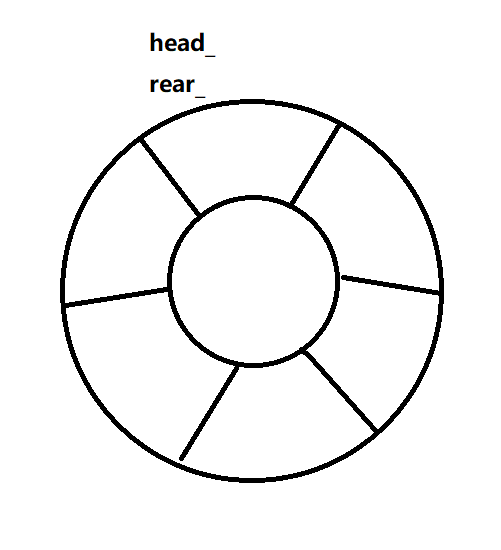环形队列
环形队列理论
环形队列的本质就是一个数组。用两个标识分别表示对头和队尾,在逻辑上呈现为一个环形
当队列不为空时,对头指向头元素,队尾指向最后一个元素的下一个元素
下图为空队列(队列的初始状态)

入队:从对尾入队,arr[rear_] = val; (rear_+1) % arr.length();
出队:从对头出队,(head_+1) % arr.length();
考虑到一个问题,队列空与队列满的表示都为 head_ = rear_; 这显然是错误的。为了解决这个问题,就不能将数组中的全部空间都使用(这会导致对头与队尾相遇,这与对空的判断吻合)。
而要预留一个数组元素
对满状态如图:

那么堆满的判断就变成了 (rear_+1) % arr.length() == head_
环形队列代码
#include<iostream>
using namespace std;
class Queue
{
public:
Queue(int size = 10)
:cap_(size)
, front_(0)
, rear_(0)
, pQue_(new int[cap_])
{
}
~Queue()
{
delete[] pQue_;
pQue_ = nullptr;
}
void push(int val)
{
if (full())
{
expand(2 * cap_);
}
pQue_[rear_] = val;
rear_ = (rear_ + 1) % cap_;
}
void pop()
{
if (empty())
throw " queue is empty";
else
{
front_ = (front_ + 1) % cap_;
}
}
int front() const
{
if (empty()) throw "queue is empty";
else
{
return pQue_[front_];
}
}
int back() const
{
if (empty()) throw "queue is empty";
else
{
return pQue_[(rear_ - 1 + cap_) % cap_];
//为了解决访问数组末尾元素
//当要访问最后一个元素时,rear_位于数组头
}
}
int size()
{
int size = 0;
for (int i = front_; i != rear_; i=((i+1)%cap_))
{
size++;
}
return size;
}
bool full() const
{
if ((rear_ + 1)%cap_ == front_)
return true;
else
return false;
}
bool empty() const
{
if (rear_ == front_)
return true;
else
return false;
}
private:
void expand(int size)
{
//不可以和栈、数组一样 使用memcpy,来进行内存拷贝
int* ret = new int[size];
int num = 0;
for (int i = front_; i != rear_; num++,i=(i + 1) % cap_)
{
ret[num] = pQue_[i];
}
delete[] pQue_;
pQue_ = ret;
front_ = 0;
rear_ = num;
cap_ = size;
}
int cap_;
int* pQue_;
int front_;
int rear_;
};
不能使用memcpy的原因

这使拷贝变得无意义
链式队列 (基于双向循环链表)
与链式栈相同,都是为了解决当数组内元素过多时,扩容的事件负责都为O(n),浪费时间。若采用链式队列,就可以使扩容操作的时间复杂度将为O(1)
#include<iostream>
using namespace std;
class listQueue
{
public:
listQueue()
{
head_ = new Node();
head_->next_ = head_;
head_->pre_ = head_;
}
~listQueue()
{
while (head_->next_ != head_)
{
Node* t = head_->next_;
head_->next_ = head_->next_->next_;
t->next_->pre_ = head_;
delete t;
}
delete head_;
head_ = nullptr;
}
void push(int val)
{
Node* p = head_->pre_;
Node* node = new Node(val);
node->next_ = head_;
node->pre_ = p;
head_->pre_ = node;
p->next_ = node;
}
void pop()
{
Node* p = head_->next_;
head_->next_ = head_->next_->next_;
p->next_->pre_ = head_;
delete p;
}
int front()
{
if (head_->next_ != head_)
{
return head_->next_->data_;
}
else throw "is empty";
}
int back()
{
if (head_->pre_ != head_)
{
return head_->pre_->data_;
}
else throw "is empty";
}
private:
struct Node
{
Node(int data = 0)
:data_(data)
,pre_(nullptr)
,next_(nullptr)
{ }
int data_;
Node* pre_;
Node* next_;
};
Node* head_; //指向头节点
};